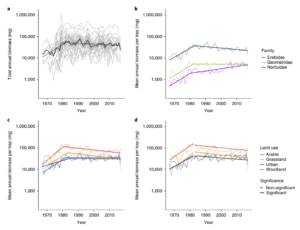It is so hard to find good news from the ongoing sixth extinction that, when this happens, one can be forgiven for disbelief. But a new paper by Macgregor et al. published on Nature Ecology and Evolution seems to cast doubt on the ongoing narrative of insectageddon, the apparent catastrophic decline in insect population.
The trick? Most papers observing a decline in the insect populations don’t go back in time much beyond year 1980. Can we grasp what happened before that, and how do data look like in this larger context? Macgregor et al. do exactly that: they found a thick dataset on British moth populations going back up to 1967, from 34 sites – the Rothamsted Insect Survey. These are mostly light traps that are counted daily, since more than 40 years. The very fact there is such a monitoring, while most of insect populations worldwide are so poorly known, is amazing.
Are moths declining? Yes – but only since 1982-ish. Before that, they were increasing. So much that today in Britain we still have more moth biomass than in 1967 -more than double, actually.

My former scientist self twitches a bit at seeing these graphs fitted with two straight lines with an arbitrary inflection point, but we can forgive this: it seems indeed in most cases the population is rising up to to the late ’70s and then plateauing or declining (Moth family Erebidae seems to just rise, however).
Another interesting thing of their dataset is that they sample urban and arable land, while other studies, like the ones from Germany, sample only protected areas. They see the population trends are different, with arable lands showing no decline, and woodlands showing the sharpest.
So, what does it mean? Is the current decline of insects a blip of a simply larger fluctuation trend? Callum Macgregor, first author of the paper, does not think we can go back to sleep, as he states on The Guardian:
“It’s absolutely not the case that everything is fine,” said Dr Callum Macgregor. “We do know that insects are in long-term decline as a whole, and also that the majority of insect species are declining.
“The concerning thing about the decline is that it’s over a 35-year period and there’s no real sign that that long-term declining trend is reversing.
“Having said that, the implication of a phrase like ‘insect Armageddon’ is that it’s an end-of-days scenario and it’s almost hopeless, and I don’t think it is hopeless. There is still time and opportunity for us to turn things around and make positive changes in the way we use our land.”
So, what was going on (apart from the birth of punk rock)? Hard to say, the author hypothesize perhaps yearly weather fluctuations such as droughts made the population oscillate, before the ongoing decline -mapping very well with the one measured elsewhere- took place.
Can we breathe? Hardly. We know that humans are causing a mass extinction since ages -at least, since we wiped out the Pleistocene megafauna. There is little doubt on that. Still, the data of Macgregor et al. are a interesting reminder that data only make sense in context, including the context of other data. Wild populations can oscillate, indeed, wildly, and long-term trends will be always superimposed on local phenomena. It’s a shame there are probably not many more long-term population data in the past to understand what is going on with insects worldwide. For now, I’m still not optimistic -but if the British moths teach us something, is that yes, there might be still time to reverse trends, since it was worse recently and ecosystems still did not collapse. But this time is not much. This is a reminder to hurry, not to relax.
The paper is: Macgregor, C. J., Williams, J. H., Bell, J. R., & Thomas, C. D. (2019). Moth biomass increases and decreases over 50 years in Britain. Nature Ecology & Evolution. doi:10.1038/s41559-019-1028-6
